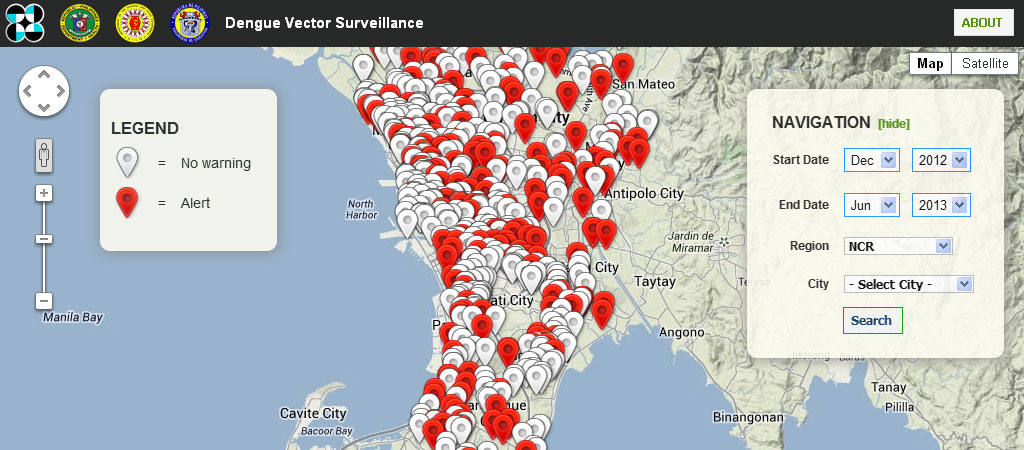SUMMARY
This is AI generated summarization, which may have errors. For context, always refer to the full article.

MANILA, Philippines – The Department of Science and Technology (DOST) on Thursday, June 20, launched a website which will show crowdsourced dengue-related information from public schools nationwide.
The Dengue Vector Surveillance website (http://dengue.pchrd.dost.gov.ph/) carries information on mosquito population nationwide, as well as dengue incidence and other mosquito-related facts.
The website is part of a program called Nationwide Dengue Vector Surveillance, an inter-agency cooperation strategy for intensifying the government’s anti-dengue drive.
Dengue, a disease common in tropical and sub-tropical countries in the world, is transmitted through the bite of an Aedes mosquito, according to the World Health Organization (WHO). Dengue fever is potentially fatal and mainly affects children.
The program began after a 2011 Memorandum of Agreement among government agencies led by the DOST, Department of Education (DepEd), Department of the Interior and Local Government (DILG) and the Department of Health (DOH).
Practical and simple
The first component of the Nationwide Dengue Vector Surveillance program is the deployment, installation and monitoring of the Ovicidal-Larvicidal (OL) traps in public elementary and high schools nationwide.
DOST Secretary Mario Montejo said the agencies chose to launch the program in schools because they are the most vulnerable places for diseases such as dengue.

“There are many children, and most of them are in school during daytime. Dengue-carrying mosquitoes are usually present at daytime,” he said in Filipino, adding that children are also prone to heavy perspiration which attracts mosquitoes.
The manufacturer of the OL trap, Heritage Veterinary Corp, is tasked to produce and deliver the kits to schools. The distribution started last June 13.
The kit is composed of 3 elements: a black container, a lawanit paddle where mosquitoes lay their eggs, and a pack of pellets used to make a solution that kills the eggs and larvae of mosquitoes. The solution made from one pack of pellet is good for one week.
The “attack and trap” OL kit is DOST’s “practical and simple technology” in reducing dengue cases in schools.
No to defogging
In the past, defogging was a common but temporary solution to alarming cases of dengue in the country. However, DepEd Health and Nutrition Center Director Dr. Ella Naliponguit said they do not recommend it.
“We don’t recommend defogging because it really doesn’t help. The mosquitoes are only displaced,” she said in Filipino, adding that DepEd only allows defogging when there is an outbreak in school.

Reporting process
The second component of the Nationwide Dengue Vector Surveillance program is the establishment of a website for dengue vector surveillance.
All information on the Dengue Vector Surveillance website will come from school coordinators.
Each classroom adviser will have two OL trap kits in the classroom. They will report weekly to the school coordinator tasked to send raw data via text messaging.
School coordinators must register their cellular phones first to be able to submit data:
FOLLOW<space>LAMOK<space>SCHOOL ID and send to 2948
After registration, their report must follow this format:
POST<space>LAMOK<space>no. of positive traps<space>no. of negative traps<space>no. of lost traps<space>date harvested and send to 2948
The report will be received by telecom Mega Mobile, which will forward the data to the Advanced Science and Technology Institute (ASTI)/Philippine Council for Health Research and Development (PCHRD) for data computation.
The website, developed by PCHRD, inherited the basic functionalities of Google Map. When a school shows a red balloon, it means the campus has a high dengue alert. A white balloon indicates otherwise.
Public schools first
Naliponguit said that OL traps will be distributed first to public schools in Metro Manila, Cebu and Davao. They hope to cover the rest of the schools nationwide within the next 2-3 years.
The DOH is in charge of funding the kit. They allocated P84 million for the project, and initially released P30 million this month.
The first fund release from DOH will cover supplies for up to 3 months of implementation. Naliponguit said they will coordinate with different government and non-government organizations in sustaining the program.
Private schools, on the other hand, may opt to buy the kits from several drug stores with a suggested retail price of P25/pack of pellet.
DOST reminded everyone that the OL trap is not the solution to the problems caused by dengue. The kit is just one of many ways to reduce the alarming number of dengue-related deaths in the country.
Last year, the DOH recorded a total of 294 deaths from dengue, a rise from the 259 death toll in 2011. – Rappler.com
Add a comment
How does this make you feel?
There are no comments yet. Add your comment to start the conversation.